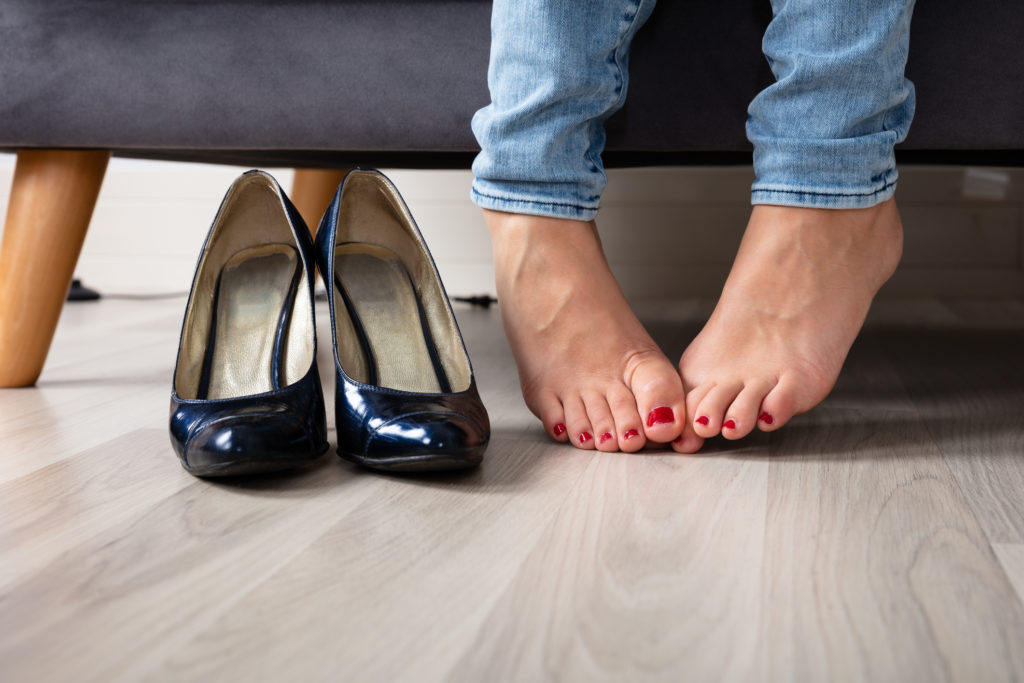Maybe you’ve had to give up wearing your favorite pair of shoes, or you are refraining from wearing open-toe shoes or sandals because you’re self-conscious about your toes. Regardless of whether your hammertoe has become too painful to live with or you want to correct the issue–you may be wondering if surgery is in your future.
Hammertoe, an abnormal bending of the toes, is a common issue, especially for women, but it doesn’t always require surgery. In many cases, hammertoes can be managed by non-surgical methods such as:
Better Shoe Selection
If you have a hammertoe, you must wear shoes with a wide, deep toe box (front of the shoe where your toes rest). This can help prevent corns and calluses that are common for people who have a hammertoe. Some people with a hammertoe find shoes made with mesh or sandals feel more comfortable on their feet.
Toe Strengthening Exercises
Another thing individuals with hammertoe should do are toe exercises. These are exercises that can help strengthen your small muscles to maintain flexibility. Flexible toes are less painful, so it’s essential to do these exercises daily.
One toe strengthening exercise to try is the Toe Crunch. This technique involves using the middle joint of your toe to pull the tip of the top to the base. You’ll want to ensure that you have a towel under your foot and are seated comfortably before starting.
- Keep your heel firmly planted on the ground and use your toes for crunching the towel up.
- Continue crunching the towel until you’ve reached the end.
- Repeat 10-12 times for best results.
- (optional) If you would like to add resistance, place an item like a book at the end of the towel.
Utilize Wearable Devices
Splints, toe wraps, and toe socks are great wearable devices that can be worn while sleeping or sitting at your desk while working. They can help to alleviate pain and make wearing shoes more comfortable.
When to Consider Surgery For Hammertoes
So how do you know when surgery is the best option to correct a hammertoe? Typically, you should consider surgery if your affected toes become stiff, painful, or limit your activity. Your doctor will advise you on this, but these are good indicators this may be your best form of treatment. The most common reason individuals end up having surgery on their hammertoe is pain. Hammertoes that are flexible and don’t cause pain are considered mild to moderate. Surgery is typically done when there is a severe deformity that is immobile and causing pain.
Additionally, while surgery is usually not recommended to fit better in shoes, your doctor may recommend this if you have trouble finding shoes that fit comfortably.
Surgery may also need to be considered if:
- Conservative treatments have not reduced or eliminated the pain
- The hammertoe has become rigid and very painful
- Sores or ulcers are developing due to hammertoes
Your podiatrist will work with you after determining the severity of your hammertoe and will work with you to develop a treatment plan aimed to reduce or eliminate the pain you are experiencing in your foot. As mentioned, when conservative options have been exhausted, surgery may be your best option.
The good news is that the recovery time from hammertoe surgery is generally minimal. Hammertoe surgery is performed on an outpatient basis, and you will be able to walk after the surgery using a special protective boot. Any pain experienced after surgery is typically due to swelling/inflammation, which can be controlled by medication as well as by keeping the foot elevated.
When thinking about your recovery from surgery, you should make sure that your home is prepared before surgery. Such preparations may include:
- Removing rugs that could be a slip or trip hazard.
- Avoiding cabinets that you commonly stub your toe on.
- Preparing a place to sleep downstairs if you have stairs in the house.
As with any outpatient surgery, you should also expect mild discomfort for the first few days.
Causes of Hammertoe
Improperly fitting shoes are the primary cause of hammertoe, as narrow-toed shoes can squish your toes into a bent position. High heels cause a similar problem since they force your toes against the front of the shoe. When shoes constrict and bend your toes over an extended time, the muscles shorten to accommodate the position and cause hammertoe.
You’re also more prone to develop a hammertoe if you have an inflammatory joint disease like arthritis. Bunions can also raise your risk because they push your big toe into your second toe, which may in turn force your second toe into a downward, hammertoe position.
Prevention is the best thing you can do regarding hammertoe, so it’s essential to choose shoes that fit correctly, especially in the toebox. If your feet are already showing signs of hammertoe, it’s not too late. Contact us today to schedule an appointment for treatment.

